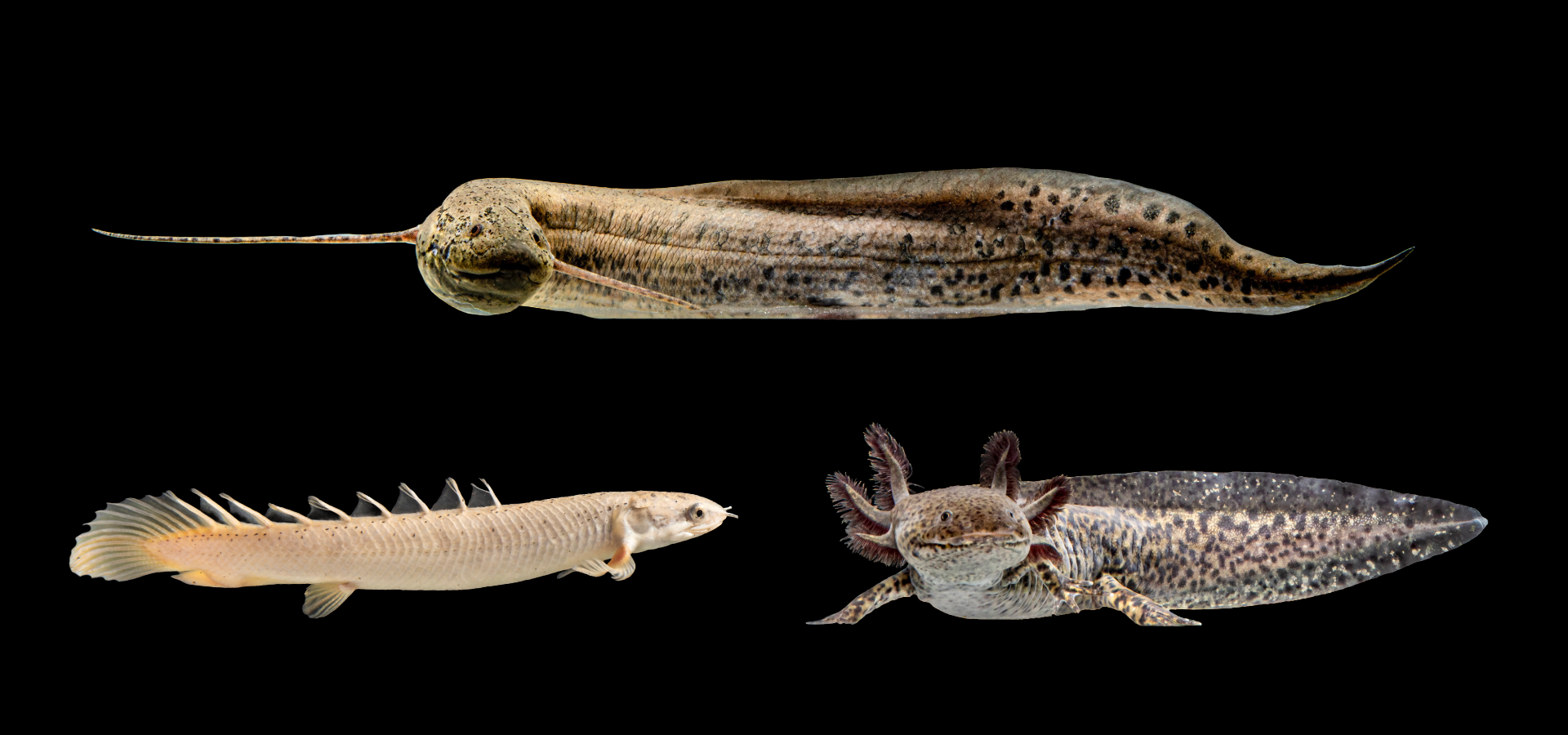Lost to Evolution: LSU's $1.2M Quest to Rediscover Limb Regeneration
September 04, 2024

A Leg Up on Science: LSU researcher explores evolution’s missing link in limb regeneration. After all, we were all fish once—but unlike highly regenerative species like the African lungfish (top), bichir (bottom left), and axolotl (bottom right), humans can't regrow limbs. Yet.
– Credits: Katherine Seghers.
Baton Rouge, LA – Why can't humans regrow arms and legs? LSU Assistant Professor Igor Schneider is taking a significant step toward solving this age-old mystery with the support of a $1.2 million grant. Schneider's research, funded by the NSF Enabling Discovery through GEnomics (EDGE) program, aims to uncover the genetic mechanisms that allow certain animals, like salamanders, to regenerate limbs while humans cannot. This groundbreaking work could lead to new treatments for injuries and diseases.
The NSF EDGE program, a collaborative effort between the National Science Foundation and the National Institutes of Health, is focused on deciphering the complex relationship between genes and their observable traits, known as phenotypes. By funding innovative tools, technologies, and research resources, EDGE seeks to reveal how genes shape biological functions and traits across diverse organisms. This research aligns with broader scientific goals, such as predicting phenotypes and understanding the fundamental rules that govern life, as outlined in NSF's Big Ideas and the priorities of the National Human Genome Research Institute.
Schneider's research targets a remarkable trait retained by some fish and salamanders but lost in other vertebrates over time: the ability to regrow complete fins and limbs. Although humans cannot currently regenerate limbs, it's possible that the genetic toolkit for regeneration still lies dormant within our DNA.
"There's strong evidence suggesting that we're not missing crucial genes necessary for wound healing and regeneration," Schneider explains. "It's likely that we still have the tools, but we're not deploying them. The answer may lie in DNA regulatory elements that activate the right genes at the right time to promote regeneration."
The loss of regenerative abilities in many land-dwelling animals is an evolutionary puzzle. While regeneration might seem beneficial, it can have significant drawbacks. For example, land animals like gazelles rely on their limbs for survival. Regrowing a lost limb takes time, leaving the animal vulnerable to predators. Additionally, the energy required for regeneration can be taxing for an already disadvantaged animal. These factors may explain why regeneration became a neutral trait, eventually lost in some species. However, the precise reasons remain unclear. Understanding the genetic basis of regeneration is key to unraveling why this ability was lost in some species but retained in others.
The project seeks to identify a shared ancestral genetic program that allows certain species to regrow fins and limbs. By understanding how humans lost this capacity, scientists may be able to explore reactivating these pathways in future biomedical research.
"We are studying species like the axolotl, a salamander that serves as a model for regeneration and development, alongside emerging model organisms such as the lungfish and bichir. These fish are highly regenerative and capable of repeatedly regrowing their complete fins with remarkable accuracy throughout their lifespan. They can also regenerate other body parts, including hearts, spinal cords, and vertebrae, which is of significant biomedical interest," Schneider adds.
The research project, titled “Shared Genetic and Cellular Mechanisms of Vertebrate Limb and Fin Regeneration,” involves collaboration with Jessica Whited's lab at Harvard, which specializes in axolotl limb regeneration, and Maksim Plikus's lab at UC Irvine, known for its work on skin regeneration and computational analysis. Whited's lab will develop transgenic axolotls to test DNA elements crucial for regeneration, while Plikus's lab will integrate single-cell RNA sequencing and spatial transcriptomics data to identify gene regulatory elements and map cell-to-cell communication during the regenerative process. The project will also use techniques such as ATAC-seq, bulk RNA sequencing, and polysome sequencing to track gene expression, protein production, and the rapid translation of mRNAs following injury. By comparing data from axolotls, lungfish, and bichir, the research aims to uncover a common genetic program for regeneration and investigate how this ability was lost in humans.
"We hypothesize that once we build a dataset of regulatory elements involved in regeneration, we can search for these elements in mammals. We expect to find some that have persisted, but we also anticipate that many may have been lost over time. This research could open paths for future biomedical efforts to rekindle or reactivate those lost pathways,” Schneider concludes.
The team’s ultimate goal is to identify the genes and regulatory elements that make up a vertebrate toolkit for limb and fin regeneration. By uncovering these biological blueprints, their research not only sheds light on our evolutionary past but also holds the promise of groundbreaking treatments that could transform the future of regenerative medicine.